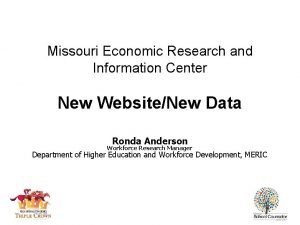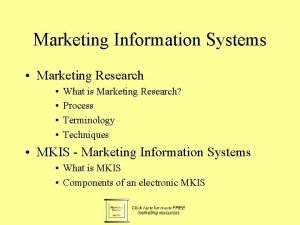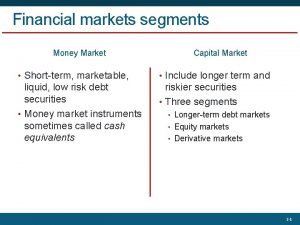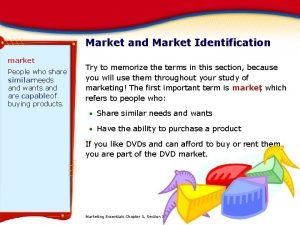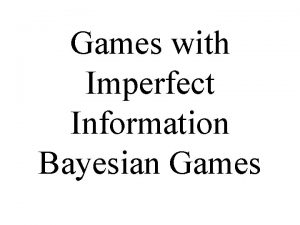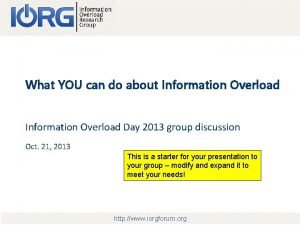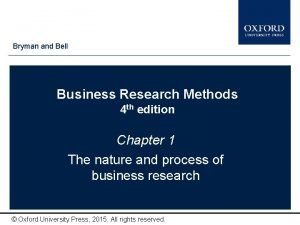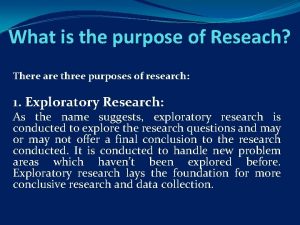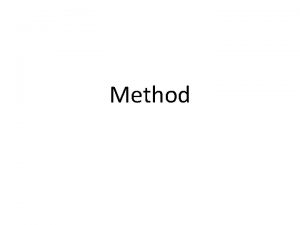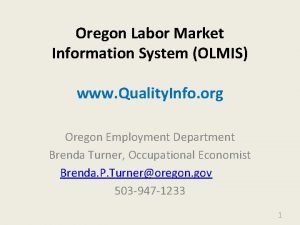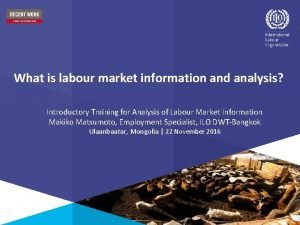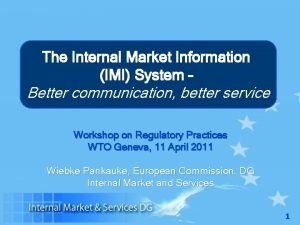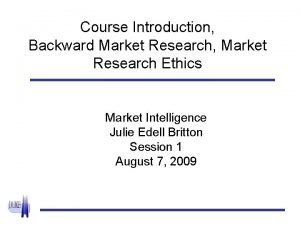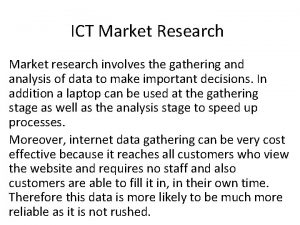Chapter 7 Market Research and Market Information Mc


















































- Slides: 50


Chapter 7 Market Research and Market Information Mc. Graw-Hill/Irwin © 2007 by the Mc. Graw-Hill Companies, Inc. All rights reserved.

Chapter Goals Market research, the need and the forms n Information systems increase the usefulness of data n Growing role of technology in marketing research n Conducting a market research project n n Gathering and using information about competitors

The Marketing Research Function Ø Marketing research is needed before a product is introduced, and on a regular basis throughout its life. Ø Research is not limited to products; it is conducted to answer questions about potential market segments, entire stores, brand names, advertising, prices, and every other aspect of marketing.

Uses of Marketing Research (where organizations use research) Markets Market Segments Marketing Mix Expectations Satisfaction Competition

Uses of Marketing Research (where organizations use research) Ø Market and market segments: research can be used to clarify the need, identify and describe exactly who has it, and determine the strength of the need in various segments. Ø Marketing mix: even when a marketer is confident that a need exists, it is not always clear what form a product should take to satisfy the need, at what price it will sell, how prospects should be informed about it, or in what fashion it should be distributed.

Ø Competition: finding out what current and potential competitors are doing and how it may affect a firm’s strategy. Ø Expectations and satisfaction: it is important to know what customer expect and how well those expectations are being satisfied.

Marketing Research ØConsists of all of the activities that enable an organization to obtain the information it needs to make decisions about its environment, marketing mix, and present and potential customers.

Marketing Research The development, interpretation, and communication of decision-oriented information to be used in all phases of the marketing process.

Marketing Research Ø This definition has two important implications: Ø 1 - Research plays a role in all three phases of the management process in marketing: planning, implementation and evaluation. Ø 2 - It recognizes the researchers’ responsibility to develop information, which includes defining problems, gathering and analyzing data, interpreting results, and presenting the information in such a way that it is useful to managers.

Scope of Marketing Research Activities (Sources of information) Syndicated Services Decision Support System Marketing Information System Marketing Research Activities Marketing Research Project

Scope of Marketing Research Activities ( Sources of information) Ø Marketing managers make use of four main sources of information: Ø 1) Syndicated services: regularly scheduled reports that are produced and sold by research firms. They are called syndicated services because they are developed without a particular client in mind, but are sold to anyone interested. Ø 2) Marketing information system: an internally coordinated activity that provides continuous, scheduled reports. Marketing information systems (Mk. IS) rely heavily on internal data such as sales reports, inventory amounts and production schedules, but they also often include information purchased from research firms.

Scope of Marketing Research Activities Ø 3) Decision support systems: it is also internal , but it is interactive. It permits a decision maker to interact directly with data through a personal computer to answer a specific question. Ø 4) Marketing research project: conducted by a company’s own staff or by an independent research firm to answer a specific question.

Marketing Information Systems On-going, organized procedure to generate, analyze, disseminate, store, and retrieve information for use in making marketing decisions.

Marketing Information Systems

Marketing Information Systems Benefits of a Mk. IS: n a. Provides a fast and more complete information flow for decision making. n b. Allows a wider variety of data to be collected and used. n c. Allows continual monitoring of marketing mix performance. n d. Provides benefits to firms of all sizes.

Decision Support Systems Computer-based Allows Interaction with Data Uses various methods of analysis Integrates, analyzes interprets information

Decision Support Systems

Decision Support Systems Ø Decision support systems (DSS)—a computer-based procedure allowing managers to interact directly with data using a variety of methods to integrate, analyze, and interpret information. n Mk. IS and DSS both rely on a wide variety of data. n They are both able to analyze data. n Unlike a Mk. IS, a manager using DSS can interact directly with data to produce customized reports.

n. A DSS complements instead of replaces an Mk. IS by adding speed and flexibility to the research process. n DSS has cost as a major drawback, which currently limits use to large firms.

Data DATABASE DATA MINING A set of related data that are organized, stored, and updated in a computer. Sophisticated techniques capable of identifying patterns and relationships in masses of data

Data Major Data Sources: n 1. Internal versus external: Internally, data can come from the sales force, sales records, marketing, manufacturing, etc. Externally, information is available from hundreds of research suppliers. n 2. Retail scanners—electronic devices at retail checkouts that read bar codes and provide relevant information with regard to individual and combined purchases.

Marketing Research Projects

Marketing Research Procedure

Marketing Research Procedure 1 - Define the objective: Researchers need a clear idea of what they are trying to learn – the objective of the project. 2 - Conduct a situation analysis: They analyze the company, its market, its competition, and the industry in general. The situation analysis is a background investigation that helps refine the research problem.

Marketing Research Procedure 3 - Conduct an informal investigation: consist of gathering readily available information from people inside and outside the company –middleman, competitors, advertising agencies, and consumers. The informal investigation is a critical step in a research project because it will determine whether further study is necessary. 4 -Plan and conduct the formal investigation: the researcher determines what additional information is needed and how to gather it.

Marketing Research Procedure 4 - Plan and conduct the formal investigation: 1 SELECT SOURCES OF INFORMATION Primary, secondary data or both can be used in an investigation. n a. Primary data—new data gathered specifically for the purposes at hand. n b. Secondary data—data already gathered for some other purpose and available for present use.

Sources of Information (sources of secondary data) Inside the company SECONDARY DATA Outside the company

SOURCES OF SECONDARY DATA n a. Records and reports from within the firm (inside the firm) n b. Libraries n c. Government (provider of demographic market information) n d. Trade, professional, and business associations Outside n e. Private research firms the firm n f. Advertising media n g. University research programs n h. Websites of firms

Sources of Information Cookies PRIMARY DATA Scanner Observation Personal Observation Laboratory Experimental Field Test Market Mail Survey Telephone Face to Face Internet

SOURCES OF PRIMARY DATA n a. n b. n c. Firm’s sales force. Firm’s suppliers. Current or potential customers.

2 - SELECT A PRIMARY DATA-GATHERING METHOD n There are three widely used methods of gathering primary data: observation, survey and experimentation. n Because each method has strength and weaknesses, more than one may be used at different stages of the project.

A. Observation method Ø Observation method: The observation method involves collecting data by observing the actions of a persons. In observation research there is no direct interaction with the subjects being studied. Information may be gathered by personal observation (the researcher poses as a customer) or mechanical observation (scanners, internet cookies…etc. )

Ø Internet Cookies are special kind of observation. A cookie is an inactive data file placed on a person’s computer hard drive when that person visits particular website. A cookie can record the visitor’s activities while connected to the site. Ø For example, it can keep track of which pages on the site are opened, how long the visitor remains at the site, the links the visitor makes to other sides, and the site from which the visitor came. Purchases can also be recorded on a cookie.

n The observation method has several merits. It can provide highly accurate data about behavior in given situations. Usually the parties being observed are unaware that they are being observed, so presumably they behave in a normal fashion. Also because there is no direct interaction with the subject, there is no limit to how many times or how long a subject can be observed. (advantages) n However, observation provides only information about what happens, it can not tell why. It can not examine motives attitudes or opinions. (limitations)

B-Survey method Data-gathering form Question wording Response format Questionnaire layout Pretesting Representative Sample Random samples Convenience samples

n Survey method consists of gathering data by interweaving people. Surveys can be conducted in persons, by telephones, by mail, or via the Internet. Advantage of surveys : n The information is first-hand. (the information comes directly from the people you are interested in) Limitations of surveys: n Error bias may originate in survey construction and the interview process. n Surveys may be expensive, time consuming, and involve problems with respondents (non-response, inability to respond, misleading responses, etc. ).

a) Face to face interviews (Personal interviews) Advantages: n Are more flexible than phone or mail interviews n More information (in-depth information) can be obtained Limitations: n Shopping mall intercept and focus groups are types of personal interviews. n High cost and time consuming nature. n Interviewer bias. (an interviewer’s appearance, style in asking questions, and body language can all influence a respondent’s answers)

b) Telephone surveys Advantages: n Save time. n Are relatively low cost and easy to administer. Limitation: n Require survey instrument to be short.

c) Mail surveys involves sending a questionnaire to potential respondents, asking them to complete, and having them return it. Advantages: n Very economical and allows wide geographic spread. n Lack of interviewer bias. Limitations: n Good mailing lists may be hard to obtain. n Low response rates and low level of control. A similar but alternate medium is the Internet; its use in research data collection is increasing.

C-Experimental methods n An experiment is a method of gathering primary data in which the researcher is able to observe the results of changing one variable in a situation while holding all other condition constant. n May be done in the lab or the field. In marketing research, a laboratory is an environment in which the researcher has control over all the relevant conditions.

A common type of field experiment is test marketing. Ø Test marketing: A method of demand forecasting in which a firm markets its new product in a limited geographic area, measures the sales, and then, projects the company’s sales over a larger area. Ø Colgate-Palmolive introduced Palmolive Optims shampoo and conditioner in Philippines, Australia, Mexico, and Hong Kong. When sales proved satisfactory, distribution was expanded to large portions of Europe, Asia, Latin America, and Africa.

3 - PREPARE FORMS FOR GATHERING DATA Researchers use a questionnaire or form on which there are instructions and spaces to record observations and responses. n Carefully choose question wording: if a question is misunderstood, the data it produces are worthless. n Determine response format: yes/no, multiple choice, agree -disagree scale, open ended. n Design questionnaire layout: begin with easier questions then move to difficult questions. n Pre-test selected forms/questionnaires: pretest on a group of respondents to identify problems and make corrections.

4 - PLAN THE SAMPLE It is unnecessary to survey or observe every person who could shed light on a research problem. It is sufficient to collect data from a sample if it is representative of the entire group. Obtaining reliable data with this method requires the right technique in selecting the sample. Sampling techniques: n a. Random samples—selected so that every member of the universe has an equal chance of being included. n b. Convenience samples—non-random samples determined by ease of access.

5 - COLLECT THE DATA Collecting primary data by interviewing, observation, or both can be done by people or machines (video cameras, retail scanners, audio tapes). Limitations: n Data gatherers are often part-time, inexperienced, untrained, not motivated. n Data gatherers may intentionally introduce false data.

5 - Analyze the data and present a report: Done by the researcher to identify relationships, trends, and patterns in written and/or oral reports. 6 - Conduct a follow-up: Conduct a follow-up to determine if recommendations are being used, the original problem was correctly defined, and the project itself was on target.

Competitive Intelligence Process of gathering and analyzing public information about competitors

Source of competitive intelligence: n 1. Data bases created and sold by research firms. n 2. Government reports. n 3. Employees—your own (especially salespeople) or those of competitors. n 4. Observation. n 5. The Internet.

Key Terms and Concepts n n n Marketing research Marketing information system Decision support system Database Data mining Retail scanners n n n n Situational analysis Informal investigation Primary data Secondary data Observation method Cookies Survey Face-to-face interviews

Key Terms and Concepts n n n n Focus group Telephone survey Mail survey Internet surveys Experiment Test marketing Competitive intelligence
 Segmenting targeting and positioning
Segmenting targeting and positioning Leader challenger follower nicher
Leader challenger follower nicher Knesset research and information center
Knesset research and information center Missouri economic research and information center
Missouri economic research and information center Finer segmentation strategy
Finer segmentation strategy Marketing information systems and marketing research
Marketing information systems and marketing research Define marketing information management
Define marketing information management Marketing information systems and marketing research
Marketing information systems and marketing research Marketing information systems and marketing research
Marketing information systems and marketing research Marketing information systems and marketing research
Marketing information systems and marketing research Basic research and applied research
Basic research and applied research Contrast applied research and basic research
Contrast applied research and basic research 40 days baby in womb
40 days baby in womb Applied vs fundamental research
Applied vs fundamental research Define research design
Define research design Practical research nature of inquiry and research
Practical research nature of inquiry and research Rephrasing the research problem
Rephrasing the research problem Q=nqp
Q=nqp Forecasting and demand measurement in marketing
Forecasting and demand measurement in marketing Genesis management and market research
Genesis management and market research Primary target market and secondary target market
Primary target market and secondary target market 6 markets model
6 markets model Capital market and money market
Capital market and money market Market identification
Market identification Document sample
Document sample Money market and its functions
Money market and its functions Incomplete information vs imperfect information
Incomplete information vs imperfect information Current research information system
Current research information system Information overload research group
Information overload research group Research report vs research proposal
Research report vs research proposal Method procedure example
Method procedure example Example of appendices in research paper
Example of appendices in research paper Research gap example
Research gap example Research paradigm example
Research paradigm example Causal-comparative research example
Causal-comparative research example Instrument in research example
Instrument in research example Basic research vs applied research
Basic research vs applied research What is reseach
What is reseach Research qualitative or quantitative
Research qualitative or quantitative Characteristics of conclusive research
Characteristics of conclusive research Characteristics of exploratory research
Characteristics of exploratory research Objectives of research example
Objectives of research example Research instrument in experimental research
Research instrument in experimental research What is qualitative research
What is qualitative research Euromonitor
Euromonitor Olmis jobs
Olmis jobs Labor market information example
Labor market information example Internal market information
Internal market information Labor market information example
Labor market information example What are the roles of marketing research
What are the roles of marketing research Nature of market research
Nature of market research



